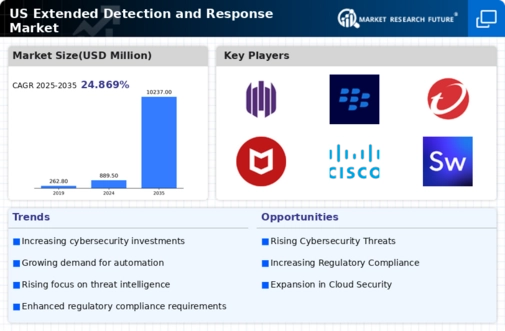Regulatory Compliance Pressures
The extended detection-response market is influenced by the increasing regulatory compliance pressures faced by organizations in the US. With regulations such as the GDPR and CCPA mandating stringent data protection measures, companies are compelled to adopt advanced security solutions. In 2025, it is anticipated that compliance-related spending will account for approximately 15% of total IT security budgets. This trend drives the demand for extended detection-response solutions that can help organizations meet compliance requirements while effectively managing security risks. The extended detection-response market is thus positioned to thrive as businesses prioritize compliance in their cybersecurity strategies.
Increasing Cybersecurity Threats
The extended detection-response market is experiencing growth due to the escalating frequency and sophistication of cyber threats. Organizations in the US are increasingly targeted by ransomware, phishing, and advanced persistent threats (APTs). In 2025, it is estimated that cybercrime will cost businesses globally over $10 trillion annually, prompting a heightened focus on robust security measures. This environment compels companies to invest in advanced detection and response solutions to safeguard their assets. The extended detection-response market is thus positioned to benefit from this trend, as organizations seek comprehensive solutions that can provide real-time threat detection and automated response capabilities.
Growth of Remote Work Environments
The extended detection-response market is significantly impacted by the growth of remote work environments, which have become increasingly prevalent in the US. As organizations adapt to flexible work arrangements, the attack surface for cyber threats expands, necessitating enhanced security measures. In 2025, it is estimated that 30% of the US workforce will continue to work remotely, prompting businesses to invest in solutions that can secure remote access and protect sensitive data. The extended detection-response market is likely to benefit from this trend, as organizations seek comprehensive solutions that can address the unique challenges posed by remote work.
Advancements in Threat Intelligence
The extended detection-response market is propelled by advancements in threat intelligence technologies that enhance the ability to detect and respond to cyber threats. As organizations in the US increasingly rely on data-driven insights to inform their security strategies, the demand for sophisticated threat intelligence solutions is on the rise. In 2025, the threat intelligence market is projected to grow by 20%, indicating a strong interest in integrating these capabilities into existing security frameworks. The extended detection-response market is thus expected to flourish as businesses seek to leverage threat intelligence to improve their detection and response capabilities.
Demand for Integrated Security Solutions
The extended detection-response market is driven by the growing demand for integrated security solutions that provide a holistic approach to cybersecurity. Organizations are increasingly recognizing the limitations of traditional security measures, which often operate in silos. In 2025, the market for integrated security solutions is projected to reach $30 billion in the US. This shift towards integrated systems encourages the adoption of extended detection-response solutions, which combine various security tools into a unified platform. The extended detection-response market is thus likely to see significant growth as businesses seek to streamline their security operations and enhance their overall security posture.


























Leave a Comment